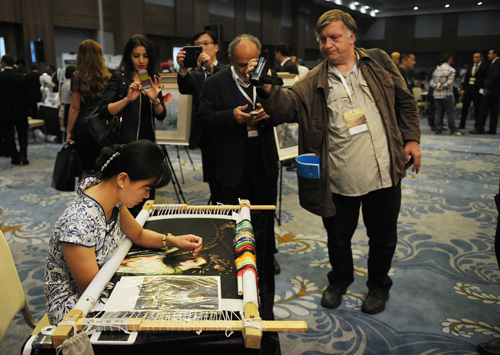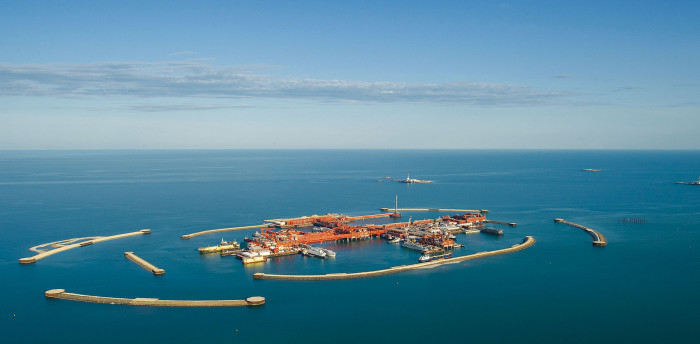 It is now unquestionable that the Asia-Pacific region is becoming the global economic center of the 21st century, currently accounting for 57 percent of global GDP. However, severe security problems remain a challenge, resulting in the rise of geopolitical wrangling and distrust within the region. The Korean Peninsula is still on the edge of conflict; Japanese politics continue to shift right; territorial and maritime disputes are simmering in South Asia and the Asia-Pacific; and West Asia remains unstable. Meanwhile, many countries in the region are plagued by terrorism, extremism, separatism, and organized crime as well as drug trafficking.
It is now unquestionable that the Asia-Pacific region is becoming the global economic center of the 21st century, currently accounting for 57 percent of global GDP. However, severe security problems remain a challenge, resulting in the rise of geopolitical wrangling and distrust within the region. The Korean Peninsula is still on the edge of conflict; Japanese politics continue to shift right; territorial and maritime disputes are simmering in South Asia and the Asia-Pacific; and West Asia remains unstable. Meanwhile, many countries in the region are plagued by terrorism, extremism, separatism, and organized crime as well as drug trafficking.
Due to the fragmented development mode of the region after the Cold War, they lack efficient economic integration, which runs counter to the trend of economic globalization. The region extends outside the world economic integration process characterized by "one axis with two wings"—the North American Free Trade Area plus the Trans-Pacific Partnership and the Transatlantic Trade and Investment Partnership—dominated by the United States and the EU. Along with a multilateral service trade agreement, this process will form a new kind of "WTO" led by Western countries.
Against this backdrop, the Conference on Interaction and Confidence Building Measures in Asia (CICA) seeks to play a stabilizing role in fostering security in the region. In the spirit of peace, harmony and unity, it is committed to strengthening dialogue, trust and cooperation among Asian countries. It also strives to promote joint development in order to build a new Asia of peace and stability. China will work with other CICA members to improve the mechanism, deepen cooperation and implement confidence building measures.
The Shanghai Summit of the CICA, scheduled to be held in May, will feature themes of security, cooperation and development. Economic development is an important part of the CICA, as security and economic growth build on one another. The CICA strengthens economic ties through encouraging mutual trade and investment among its members. Its economic cooperation mainly focuses on developing various forms of traffic networks; building a safe and effective transportation corridor; improving efficiency and security of regional transportation and energy supply; expanding trade, investment, finance and tourism cooperation among member states; encouraging communication and cooperation in the field of information technology; and establishing an economic and trade database.
Creating impetus
The initiatives of the Silk Road Economic Belt and the Maritime Silk Road of the 21st Century proposed by Chinese President Xi Jinping will become an important driving force for economic cooperation among CICA member states.
The two initiatives have formed a new pattern for China's all-round opening up and a new framework for its neighborhood diplomacy, marking a substantial change in its opening-up strategy. The country is moving away from its strict focus on attracting foreign investment, seeking equilibrium between foreign investment and investment overseas. As it reaches out to countries to its west, China will speed up the development of its western region. Meanwhile, by pushing for free trade agreements (FTAs) with its neighboring countries, it aims to promote the free flow of labor, capital and commodities in keeping with the trend of world economic integration.
The Silk Road Economic Belt is based on the opening up and development of China's western region. China will build the second Eurasian Land Bridge that runs through the northwest part of the country and links the Pacific Ocean to the Baltic Sea. It will speed up its cooperation on energy and infrastructure development with Central Asian countries. It will also promote the establishment of an FTA with the EU. All these efforts will help connect Central Asia with the EU, the largest economy in the world, and Asia-Pacific region, the world's economic center of gravity. The China-Pakistan Economic Corridor will serve as a passageway connecting China's Xinjiang Uygur Autonomous Region with the Indian Ocean. In addition, the Bangladesh-China-India-Myanmar Economic Corridor will link China's southwest with Southeast Asia.
The Maritime Silk Road is based on the opening up of China's southeast coastal region toward the Asia-Pacific. It includes trade facilitation measures such as conducting FTA talks between China, Japan and South Korea, deepening trade, finance and investment cooperation between the Chinese mainland and Taiwan, creating an upgraded version of the China-ASEAN FTA as well as launching FTA negotiations between China and Australia. The Maritime Silk Road could even extend northward, connecting with Russia's Arctic sea routes and strengthening cooperation on the construction of infrastructure such as ports between China and Russia.
China's drive to rejuvenate its northeastern industrial bases tallies favorably with Russia's Far East development strategy. The Vladivostok APEC Summit in 2012 marked the start of Russia's new Asia-Pacific strategy. The current Western sanctioning triggered by the Ukrainian crisis has further forced Moscow to shift its strategic focus eastward, urging Russia's eastern region to join the Asia-Pacific's political and economic integration process. The further development of the region—including the reconstruction of the Trans-Siberian Railway, energy resource exploitation, infrastructure construction as well as agricultural development—calls for in-depth international financial and technological collaboration. Against this backdrop, China and Russia need to renew their regional development cooperation plan for China's northeast and Russia's Far East reached in 2009 to further facilitate their cooperation.
Global impact
The two silk roads will boost regional connectivity with railways, highways, airways, sea lanes, oil and gas pipelines, power transmission lines and communication networks. They will connect the Asia-Pacific with the EU, providing new opportunities for the development of Eurasia. Extensive interaction among Eurasian countries via policy communication, traffic connection, free trade and free flow of currency will vigorously promote regional economic development as well as peace, harmony and stability of the region. Across-the-board cooperation among these countries in terms of capital, human resources, technology and information can help unleash new economic growth potential and finally shape a huge Eurasian market.
Compared with the Russia-led Eurasian integration process and the New Silk Road initiated by the United States, the most important features of the two silk roads of China are openness and inclusiveness. The Eurasian integration process is to reintegrate former Soviet Union countries through a customs union and the Eurasian Economic Union, which excludes the participation of China. The U.S. New Silk Road, aimed at help Central Asian countries to get rid of dependence on Russia and China, plans to open up a passageway from Central Asia to the Indian Ocean through Afghanistan, Pakistan and India. Similarly, the EU-backed Transport Corridor Europe-Caucasus-Asia is to free Central Asian countries from Russian dependence.
China's two silk roads are not exclusive; instead they are open to all countries and regions, allowing them to share development outcomes. The two silk roads, together with Russia's Trans-Eurasian Development Belt, can promote Eurasian economic integration and build the Eurasian market. The participation of countries from the Asia-Pacific region and Europe will form a new pattern of economic integration, which will have a major impact on the current world economic landscape and help usher in a new political and economic order worldwide.
The author is director of the Center for Russian and Central Asian Studies at the Shanghai Institutes for International Studies
Email us at:
About the CICA
The CICA was first proposed by Kazakhstan's President Nursultan Nazarbayev at the 47th Session of the UN General Assembly in October 1992. The international forum aims to strengthen cooperation to safeguard the peace, security and stability of Asia. It provides a multilateral consultation mechanism acceptable to Asian countries with different political systems and economic development levels.
The Secretariat of the CICA is located in Almaty, Kazakhstan's largest city. The leaders of its member states hold summits every four years. The CICA currently has 24 member states, covering 90 percent of the territory and population of the Asian Continent. It also has more than 10 observer states and observer international organizations. China, which holds its presidency from 2014 to 2016, will host a CICA summit in Shanghai in May.
In the past more than 20 years, the CICA has achieved rapid development with the adoption of a series of new confidence-building measures. These measures touch on the fields of economy, ecology and culture, responding to new challenges and threats such as terrorism, money laundering, drug smuggling and human trafficking, military cooperation and politics.
www.bjreview.com.cn




